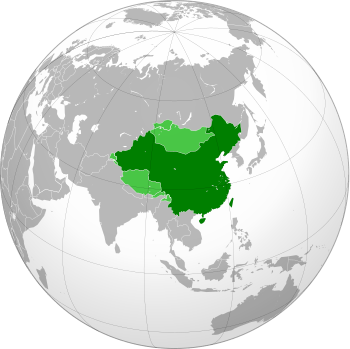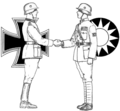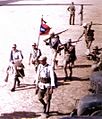Republic of China (1912–1949) facts for kids
Quick facts for kids
Republic of China
中華民國
Zhonghua Minguo |
|||||||||||
|---|---|---|---|---|---|---|---|---|---|---|---|
| 1912–1949 | |||||||||||
|
|
|||||||||||
|
Anthem:
Flag anthem:
《中華民國國旗歌》 "National Flag Anthem of the Republic of China" (1937–1949) |
|||||||||||

Location and maximum extent of the territory claimed by the Republic of China (1945).
|
|||||||||||
| Capital | Beijing (1912–1928) Nanjing (1927–1949) Chongqing (1937–1946) |
||||||||||
| Largest city | Shanghai | ||||||||||
| Official languages | Standard Chinese | ||||||||||
| Recognised national languages | Tibetan Chagatai/Uighur Manchu Mongolian and other languages |
||||||||||
| Official script |
|
||||||||||
| Religion | see Religion in China | ||||||||||
| Government | Federal semi-presidential republic under Beiyang rule (1912–1928) One-party state under a military dictatorship (1928–1946) Unitary parliamentary constitutional republic (1946–1949) |
||||||||||
| President | |||||||||||
|
• 1912
|
Sun Yat-sen (first, provisional) | ||||||||||
|
• 1949–1950
|
Li Zongren (last in Chinese mainland, acting) | ||||||||||
| Premier | |||||||||||
|
• 1912
|
Tang Shaoyi (first) | ||||||||||
|
• 1949
|
He Yingqin (last in Chinese mainland) | ||||||||||
| Legislature | Parliament | ||||||||||
| National Assembly | |||||||||||
| Legislative Yuan | |||||||||||
| History | |||||||||||
| 10 October 1911–12 February 1912 | |||||||||||
|
• Republic of China proclaimed
|
1 January 1912 | ||||||||||
|
• Beiyang government in Peking
|
1912–1928 | ||||||||||
|
• Northern Expedition
|
1926–1928 | ||||||||||
|
• Nationalist government in Nanking
|
1927–1949 | ||||||||||
| 1927–1936, 1946–1950 |
|||||||||||
| 7 July 1937–2 September 1945 | |||||||||||
|
• People's Republic of China proclaimed
|
1 October 1949 | ||||||||||
|
• Government moved to Taipei
|
7 December 1949 | ||||||||||
| Area | |||||||||||
| 1912 | 11,077,380 km2 (4,277,000 sq mi) | ||||||||||
| 1946 | 9,676,204 km2 (3,736,003 sq mi) | ||||||||||
| Population | |||||||||||
|
• 1912
|
432,375,000 | ||||||||||
|
• 1920
|
472,000,000 | ||||||||||
|
• 1930
|
489,000,000 | ||||||||||
|
• 1946
|
535,418,000 | ||||||||||
|
• 1949
|
541,670,000 | ||||||||||
| Currency | |||||||||||
| Time zone | UTC+5:30 to +8:30 (Kunlun to Changpai Standard Times) | ||||||||||
| Driving side | right | ||||||||||
| ISO 3166 code | TW | ||||||||||
|
|||||||||||
| Today part of | |||||||||||
|
Populations from http://www.populstat.info/Asia/chinac.htm
|
|||||||||||
The Republic of China (ROC) was a country that existed in East Asia between 1912 and 1949. It was the government of mainland China before the current People's Republic of China (PRC). The ROC was formed in January 1912 after the Xinhai Revolution, which ended the last imperial family of China, the Qing dynasty.
The first president of the Republic of China was Sun Yat-sen. His political party, the Kuomintang (KMT), won the first parliamentary election in December 1912. However, Sun soon gave up his position to Yuan Shikai, who was the leader of the powerful Beiyang Army. This army also controlled the Beiyang government.
Contents
Early Years of the Republic (1912-1928)
Yuan Shikai's Rule
Between late 1915 and early 1916, Yuan Shikai tried to make himself the Emperor of China. But many people did not like this idea. This led to a conflict called the National Protection War, where different groups fought against his plan. Yuan Shikai soon gave up the idea of being emperor.
After Yuan Shikai died in 1916, the Beiyang government became weaker. There was even a short time when the Qing dynasty tried to return to power.
The Warlord Era
After Yuan's death, different groups within the Beiyang Army started to claim independence. These groups were led by powerful military commanders known as "warlords." They fought each other for control over different parts of China. This period, from 1916 to 1928, is known as the Warlord Era.
In 1921, the KMT, led by Sun Yat-sen, set up a different government in Canton. They were supported by the Communist Party of China (CPC), a new political group.
During this time, northern China faced many problems. People were heavily taxed, and the constant fighting among warlords harmed the economy between 1927 and 1928.
Nationalist Government and Civil War (1928-1949)
Rise of Chiang Kai-shek
After Sun Yat-sen passed away, General Jiang Jieshi became the new leader of the KMT. In 1926, Jiang started a military campaign called the Northern Expedition. His goal was to defeat the warlords and unite China under the KMT government. By 1928, he successfully overthrew the Beiyang government.
In April 1927, Jiang Jieshi established a new nationalist government in Nanjing. Around this time, there were serious clashes between the KMT and the Communists in Shanghai. This led the CPC to start an armed rebellion, marking the beginning of the Chinese Civil War.
Challenges and Conflicts
Even though China began to modernize and develop its industries, it faced many challenges. There were ongoing conflicts between the Nationalist government in Nanjing, the CPC, the remaining warlords, and the Empire of Japan.
Eventually, the Chinese people united to fight a common enemy: the Japanese. In 1937, the Imperial Japanese Army invaded China, starting the Second Sino-Japanese War. This war was a major part of World War II.
In 1945, Japan surrendered, bringing an end to World War II and the Sino-Japanese War.
End of the Republic of China on Mainland
After Japan's surrender, the Chinese Civil War between the KMT and the CPC restarted in 1946. The fighting was intense.
By 1949, the Communist Party of China had defeated the KMT. On October 1, 1949, the CPC officially announced the creation of the People's Republic of China (PRC) on the mainland.
Jiang Jieshi and the KMT government then moved to the island of Taiwan.
Images for kids
-
Sun Yat-sen, the founding father of the Republic of China.
See also
 In Spanish: República de China (1912-1949) para niños
In Spanish: República de China (1912-1949) para niños













